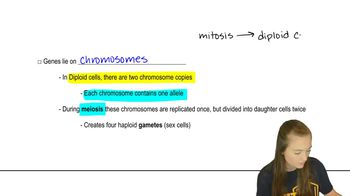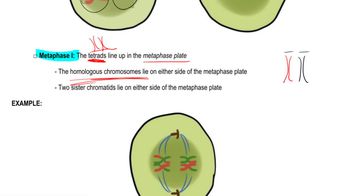How do we know that chromosomes exist in homologous pairs?
Table of contents
- 1. Introduction to Genetics51m
- 2. Mendel's Laws of Inheritance3h 37m
- 3. Extensions to Mendelian Inheritance2h 41m
- 4. Genetic Mapping and Linkage2h 28m
- 5. Genetics of Bacteria and Viruses1h 21m
- 6. Chromosomal Variation1h 48m
- 7. DNA and Chromosome Structure56m
- 8. DNA Replication1h 10m
- 9. Mitosis and Meiosis1h 34m
- 10. Transcription1h 0m
- 11. Translation58m
- 12. Gene Regulation in Prokaryotes1h 19m
- 13. Gene Regulation in Eukaryotes44m
- 14. Genetic Control of Development44m
- 15. Genomes and Genomics1h 50m
- 16. Transposable Elements47m
- 17. Mutation, Repair, and Recombination1h 6m
- 18. Molecular Genetic Tools19m
- 19. Cancer Genetics29m
- 20. Quantitative Genetics1h 26m
- 21. Population Genetics50m
- 22. Evolutionary Genetics29m
9. Mitosis and Meiosis
Mitosis
Problem 2a
Textbook Question
Our closest primate relative, the chimpanzee, has a diploid number of 2n = 48. For each of the following stages of M phase, identify the number of chromosomes present in each cell.
End of mitotic telophase
 Verified step by step guidance
Verified step by step guidance1
Understand that the diploid number (2n) represents the total number of chromosomes in a somatic cell of the organism. For chimpanzees, this is 48 chromosomes.
Recall that during mitosis, the goal is to produce two genetically identical daughter cells, each with the same diploid number of chromosomes as the parent cell.
At the end of mitotic telophase, the chromosomes have been separated into two groups, one for each forming daughter cell. However, the cell has not yet fully divided (cytokinesis has not occurred).
Each group of chromosomes in the forming daughter cells will have the same diploid number as the parent cell, which is 48 chromosomes.
Conclude that at the end of mitotic telophase, each forming daughter cell contains 48 chromosomes, and the total number of chromosomes in the entire cell (before cytokinesis) is 96 (48 in each group).
 Verified video answer for a similar problem:
Verified video answer for a similar problem:This video solution was recommended by our tutors as helpful for the problem above
Video duration:
41sPlay a video:
Was this helpful?
Key Concepts
Here are the essential concepts you must grasp in order to answer the question correctly.
Diploid Number
The diploid number (2n) refers to the total number of chromosomes in a somatic cell, where chromosomes exist in pairs. In the case of chimpanzees, the diploid number is 48, meaning there are 24 pairs of homologous chromosomes. This concept is crucial for understanding how chromosomes are distributed during cell division.
Recommended video:
Guided course

Diploid Genetics
M Phase of Cell Cycle
The M phase, or mitotic phase, is the part of the cell cycle where cell division occurs, including mitosis and cytokinesis. During this phase, the cell undergoes several stages: prophase, metaphase, anaphase, and telophase, leading to the separation of sister chromatids and the formation of two daughter cells. Understanding the M phase is essential for determining the number of chromosomes at various stages of cell division.
Recommended video:
Guided course

Bacteriophage Life Cycle
Mitotic Telophase
Mitotic telophase is the final stage of mitosis, where the separated sister chromatids reach opposite poles of the cell and begin to decondense back into chromatin. At the end of telophase, the cell has two nuclei, each containing the same diploid number of chromosomes as the original cell. Therefore, at the end of mitotic telophase in chimpanzees, there would be 48 chromosomes in each daughter nucleus.
Recommended video:
Guided course

Meiosis Steps
Related Videos
Related Practice
Textbook Question
389
views


